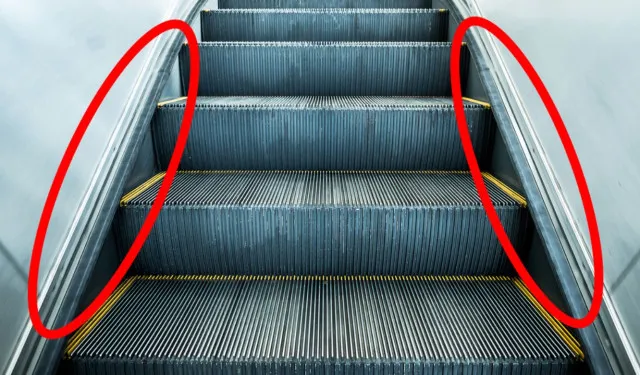Escalators are an integral part of modern life, ferrying millions of people daily through shopping malls, airports, and public transit stations. While these moving stairs may seem simple, they are meticulously designed with safety and efficiency in mind. One such thoughtful design element is the grooves on escalator steps. Though they might look like a minor aesthetic choice, these grooves serve critical functions that make escalators safer and more reliable.

How Do Escalator Grooves Work?
The grooves on escalator steps aren’t there for decoration; they are a crucial part of the escalator’s design. These grooves align with a comb-like plate, aptly named the “comb plate,” located at the top and bottom of the escalator. As the steps transition onto or off the moving mechanism, the grooves and comb plate interlock, ensuring a smooth and seamless operation.
Here’s why this design matters:
- Prevents Objects from Getting Stuck: The grooves help prevent small objects like keys, coins, or pieces of shoes from getting lodged between the steps and the floor. Without them, escalators could jam or, worse, lead to accidents.
- Improves Safety: Grooves act as a barrier against loose items such as shoelaces or bag straps, reducing the likelihood of these items becoming entangled in the moving parts.
- Reduces Slippage: While not their primary purpose, grooves help channel liquids or debris away from the surface of the steps, minimizing the risk of slipping.
These grooves ensure escalators remain functional and safe, even under heavy daily use.
What Are Safety Brushes on Escalators?
In addition to grooves, many escalators feature small brushes along the edges of the steps. While these brushes might look like they’re there to clean the escalator, their true purpose is safety.
- Preventing Snags: The brushes keep clothing, shoelaces, and bag straps from getting caught in the narrow gap between the steps and the side panel (known as the skirt).
- Psychological Cue: When the brushes touch a passenger’s leg, it instinctively prompts them to step away from the edge, reducing the risk of accidents.
Safety brushes became a mandatory feature under British and European standards in 2004, reflecting the importance of these seemingly minor additions. Together with grooves, they create a safer environment for escalator riders.

How Grooves Handle Liquid Spills
One lesser-known benefit of escalator grooves is their ability to manage liquid spills. If someone accidentally spills a drink on the steps, the grooves direct the liquid into their channels, preventing it from pooling on the surface. This simple feature keeps the steps relatively dry and reduces the risk of passengers slipping.
In high-traffic areas, where escalators are exposed to frequent spills, this functionality is critical for maintaining a safe and reliable system.
Why These Features Are Essential for Escalator Safety
With millions of people relying on escalators daily, even small design flaws could lead to significant safety risks. Grooves and safety brushes work together to minimize accidents and ensure smooth operation.
Key Benefits of These Features:
- Preventing Accidents: By stopping objects and clothing from becoming trapped, these features help avoid injuries.
- Protecting the Escalator Mechanism: Grooves prevent debris from clogging the system, reducing the likelihood of mechanical breakdowns.
- Ensuring Reliability: These thoughtful design elements minimize downtime and maintenance needs, keeping escalators dependable in busy environments.
Escalator Engineering: A Balance of Safety and Convenience
Though escalators appear simple, they are intricate machines with a carefully crafted design. Every element—from the grooves on the steps to the brushes along the sides—has been engineered to balance safety and efficiency.
- Grooves for Smooth Transitions: The alignment of the grooves with the comb plate ensures the escalator runs without jamming or misaligning the steps.
- Brushes for Added Protection: These brushes act as a safeguard, preventing items from getting caught in the escalator’s moving parts.
- Durable Materials: Escalator steps are made from sturdy materials like metal, capable of withstanding heavy daily traffic without wearing out quickly.
These features collectively make escalators safe, reliable, and efficient for millions of users every day.
A Subtle Reminder of Thoughtful Design
The next time you step onto an escalator, take a moment to notice the grooves under your feet and the brushes at the edges. These small details are quietly working to keep you safe and ensure a smooth ride.
While they may go unnoticed by most, they’re a testament to the thoughtful engineering behind one of the most common tools in modern life. Whether you’re rushing through an airport or leisurely strolling through a mall, these features protect you from potential hazards while ensuring escalators run smoothly.
Conclusion: Small Details with a Big Impact
Grooved escalator steps and safety brushes might not grab your attention, but they are indispensable for the safety and functionality of these everyday machines. By preventing objects, liquids, and clothing from causing issues, these features ensure a safer and more reliable experience for millions of riders worldwide.
So, the next time you ride an escalator, remember that those grooves and brushes aren’t just minor details—they’re key elements of a design that quietly works to keep you safe.





